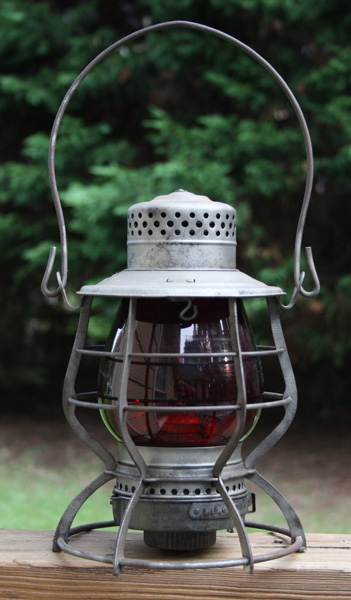

JeffPo's Atlantic Coast Line Railroad Lantern Page
Last update: 08/23/10


This Keystone company lantern was used by the Atlantic Coast Line Railroad. The brim of the lantern is stamped with A.C.L. The red globe means that it was used as a stop signal.
This style of lantern is generally referred to as a "Casey".

Image of the Casey fuel fount and burner.
The Casey lantern was unique in that you adjusted the wick by turning a knob at the bottom of the lantern. The turning knob would rotate the entire fount. The burner had a gear on it with the teeth in the slots at the top of the fount. As the fount turned, it would turn the gear/wheel on the burner, thus raising or lowering the wick. This is quite a complex way of adjusting a wick. I would fear that the more complexity you have in a system design, the more changes you have of a failure. But these lanterns proved to be popular. As a testament to the robustness of the design, many of these lanterns still work today.
Atlantic Coast Line Railroad

ACL steam engine on display in Jacksonville, FL.
The Atlantic Coast Line Railroad (ACL) existed from 1898 until 1967. The ACL was organized in May of 1898 as a holding company for a system of railroads in Virginia, North Carolina, South Carolina, Georgia, and Florida. Among these was the Wilmington and Weldon Railroad (headquartered in Wilmington, NC), which was charted in 1835. At its track completion in 1840, the Wilmington and Weldon line was the longest railroad in the world with 161.5 miles of track.
The Atlantic Coast Line Railroad was formally formed in April of 1900 as a merger of the two companies in Virginia and South Carolina, as well as the Wilmington and Weldon Railroad and Norfolk and Carolina Railroad. Through the years the ACL bought many other railroads. It acquired the Plant System in 1902. It also bought the large Louisville and Nashville Railroad the same year, though it ran it as a separate railroad. The ACL bought the Conway Coast and Western Railroad in 1912 which gave it access to Myrtle Beach, SC. Throughout the 1920s the ACL bought many and various short line railroads such as the Rockingham Railroad and the Moore Haven and Clewiston Railway.

Atlantic Coast Line passenger car on display in Rocky Mount, NC.
The Atlantic Coast Line also had some notable passage trains such as the Everglades (New York – Jacksonville) and the Florida Special (New York – Miami). The purple ACL diesel really stood out.

The Atlantic Coast Line merged with its long time competitor, the Seaboard Railroad in July of 1967. They formed the Seaboard Coast Line Railroad (SCL). Passenger service was turned over to Amtrak in 1971. By 1972, the SCL was part of the Family Lines System. The Family Lines System, along with the Chessie System, became subsidiaries of the CSX Corporation in November of 1980. The Family Lines System became the Seaboard System in December of 1982. In July of 1986, the Seaboard System’s name was changed to CSX Transportation and is how it exists today.